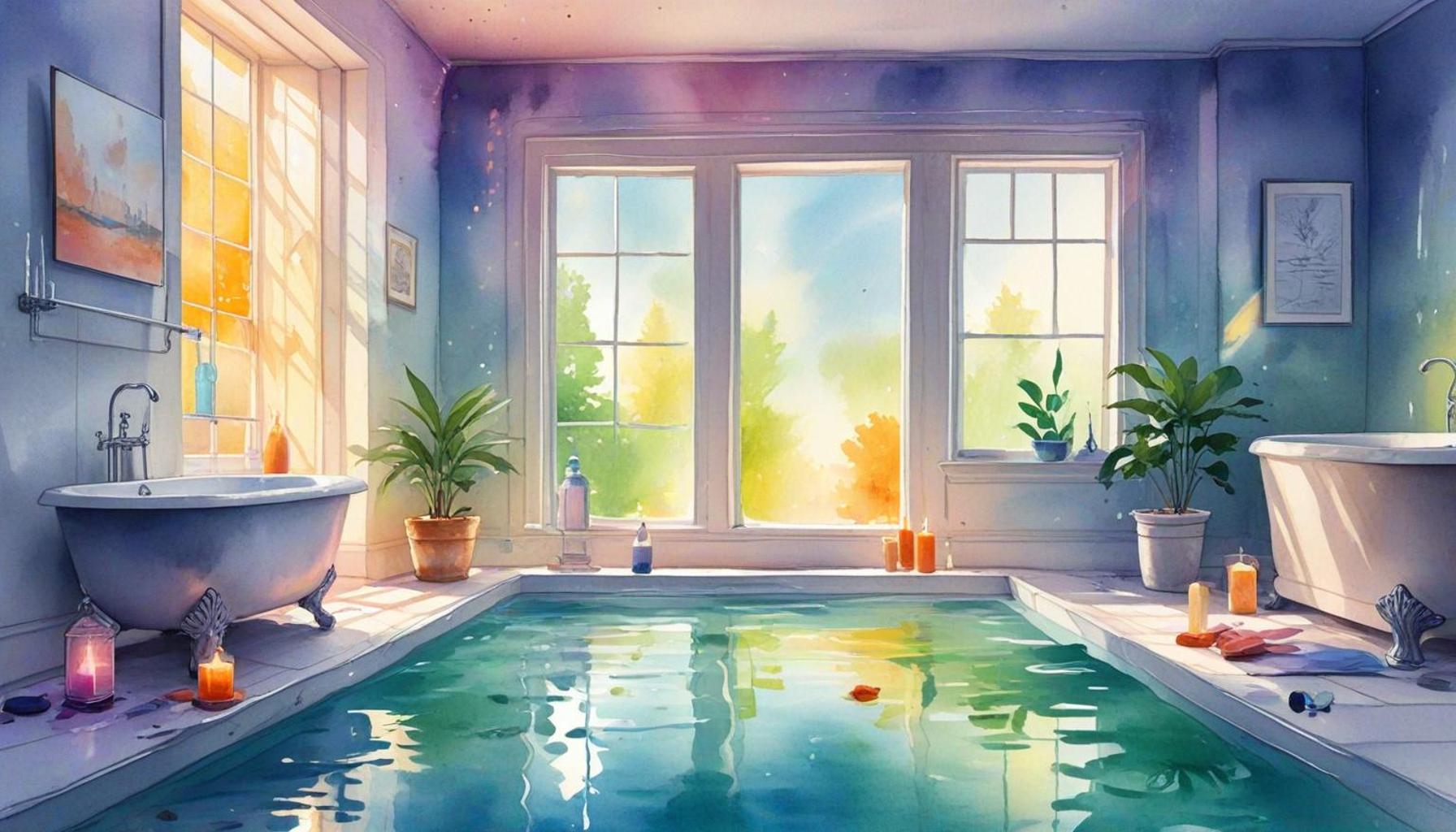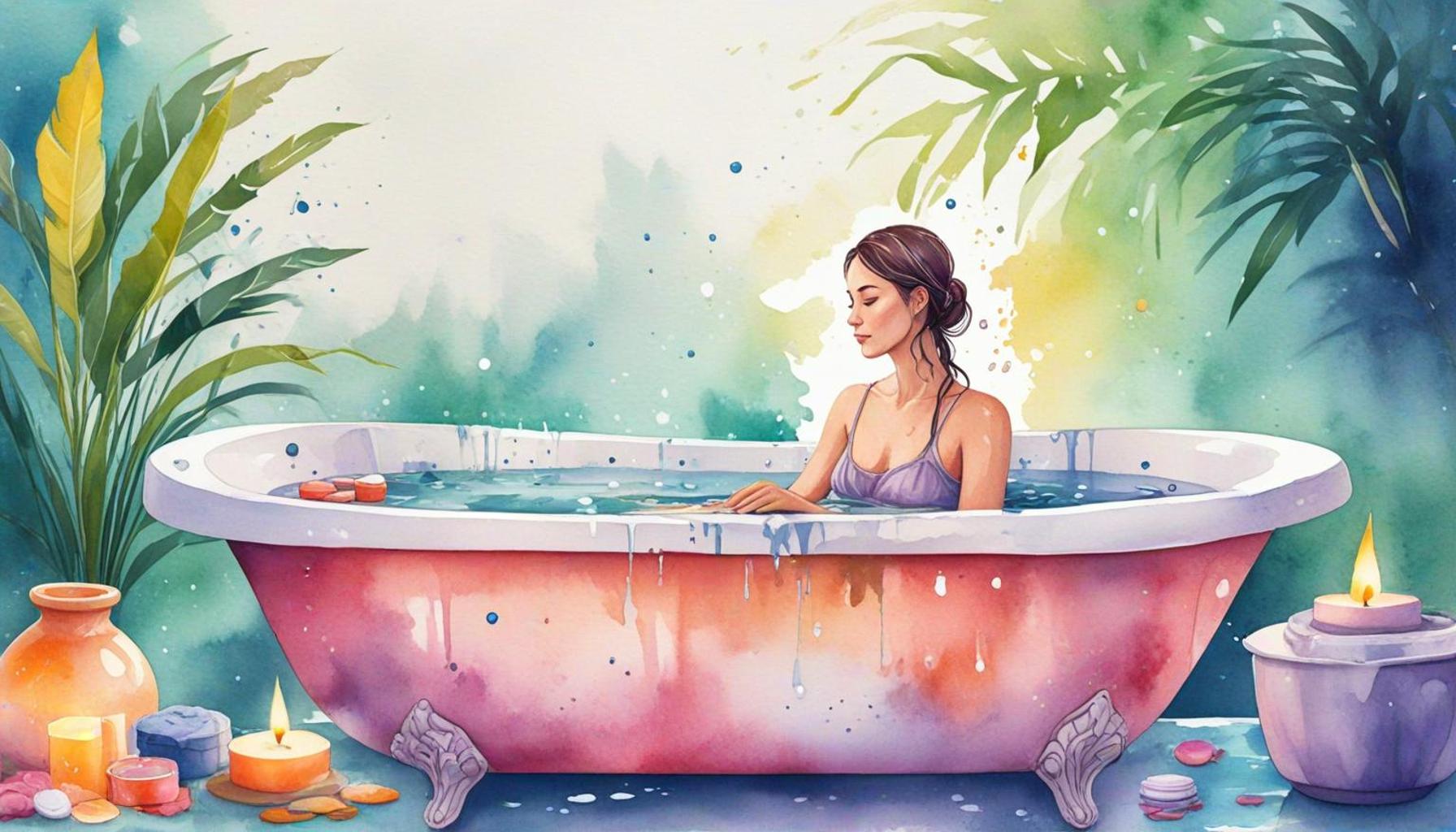The Influence of Lighting on Bath Meditation: Creating Favorable Environments for Mindfulness

The Role of Lighting in Mindful Bath Meditation
The environment we immerse ourselves in can deeply shape our experiences, particularly when it comes to mindfulness practices like bath meditation. Among the various environmental elements, lighting stands out as a vital contributor to fostering a serene atmosphere. When we harness the right lighting, a mundane bath can evolve into a sacred space of tranquility, allowing for a more profound connection to self and spirit.
Natural Light: A Connection to the Outdoors
Embracing natural light is one of the simplest yet most effective ways to enhance the mood during bath meditation. Natural sunlight not only serves as a natural source of illumination but also evokes feelings of stability and happiness. In urban Nigerian settings, where the hustle and bustle can often create a sense of disconnection, maximizing sunlight exposure during the day can restore a feeling of equilibrium. For instance, soaking in a bathtub near a window during sunset can offer a vivid display of colors, enhancing relaxation and promoting a sense of unity with nature.
The Warmth of Candlelight
Incorporating candles into bath meditation rituals can transform the space into a relaxing haven. The soft flickering flames produce a warm glow that invites intimacy and closeness, elements that are essential to deepening the meditative experience. In many Nigerian households, using locally made candles infused with scents like frankincense or shea butter can not only add an aromatic layer but also evoke comforting memories. Lighting a few candles around the bath can cradle the individual in a cascade of serenity, effectively allowing the mind to unwind.
Color and Emotion
The colors we choose to illuminate our spaces can significantly influence our emotional state. Research suggests that softer hues, such as whites, greens, and pastels, can project calmness, while deeper blue tones often promote clarity of thought. In Nigeria, where vibrant colors permeate everyday life, one can creatively incorporate colored lights or dimmers to adjust ambiance according to the mood desired. For instance, blue-hued lighting during meditation can encourage a reflective mindset, whereas green can foster feelings of renewal and peace.
In bustling Nigerian cities, the art of creating a calming bath space through thoughtful lighting is not just a luxury; it’s a powerful tool for achieving mindfulness. Emphasizing these aspects invites us to explore how simple adjustments can lead to extraordinary benefits for our mental and emotional health. Investing time in setting the right lighting can turn a standard bath into a rejuvenating retreat, enhancing the overall meditation experience. Through these conscious choices, we can reclaim our peace and foster a deeper connection with ourselves.

YOU MAY ALSO LIKE: Read read another article
Creating Sacred Spaces: The Essence of Lighting in Bath Meditation
When individuals seek solace and mindfulness in their bath meditation practices, lighting serves as an essential element that can either enhance or detract from the experience. By understanding how lighting impacts our mood and mental clarity, one can transform an ordinary bathing ritual into a profound journey of introspection. In Nigeria, where the interplay of light and environment is heavily influenced by cultural beliefs and natural settings, the thoughtful use of lighting can elevate the practice of meditation to spiritual heights.
The Psychological Impact of Light on Well-Being
The science of psychological effects of lighting reveals that different light intensities and qualities can impact our feelings and thoughts. Bright, harsh lighting may leave one feeling anxious or overwhelmed, while softer, ambient lighting can invite tranquility and comfort. In a study conducted by the University of Michigan, it was found that exposure to natural light during the day can elevate mood and reduce stress levels. This discovery nudges us to consider how we might replicate similar effects during bath meditation practice.
In many urban Nigerian neighborhoods, where housing can be smaller and often crowded, utilizing soft lighting options like adjustable lamps or dimmable overhead lights becomes crucial. These lighting solutions can help create an atmosphere conducive to deep self-reflection and mindfulness. Experts further suggest using lighting that mimics the golden hour—a period just after sunrise or before sunset—when the sun casts a warm, inviting glow. This can significantly amplify the relaxing properties of a bath environment.
Layering Light: A Holistic Approach
To achieve an optimal ambiance during bath meditation, consider employing a layered lighting strategy. This involves combining various forms of lighting to create depth and texture in your bath space. Recommended layers include:
- Ambient Lighting: This serves as the primary source of general illumination. Choose soft fixtures that distribute light evenly.
- Task Lighting: More focused lighting that allows visibility for specific actions, such as reading or journaling while soaking. Table lamps or wall sconces can supply this light.
- Accent Lighting: Use this to draw attention to essential features like plants or artwork. Colored bulbs or fairy lights can enhance the aesthetics.
In Nigerian culture, the symbolism of light is often intertwined with spirituality and enlightenment. Using layered lighting in a bath meditation practice can thus serve not only functional purposes but also spiritual ones. By designing a personalized lighting scheme, individuals can infuse their space with meaning, helping to clear cluttered thoughts while honoring the cultural narrative that surrounds light.
Ultimately, our choices around lighting during bath meditation hold tremendous potential to enhance the experience. By incorporating various forms of lighting thoughtfully, individuals can cultivate an inviting atmosphere where one can explore their thoughts, deepening the relationship between mind and body.
| Lighting Type | Effects on Meditation |
|---|---|
| Natural Light | Encourages a sense of peace and connection to nature, enhancing mindfulness practices. |
| Soft Artificial Lighting | Promotes relaxation and removes distractions, allowing for deeper introspection during meditation sessions. |
| Colored Lighting | Can influence emotional states, with colors like blue and green offering tranquility, aligning with meditative goals. |
Incorporating the right lighting into your meditation space profoundly influences the quality of your practice. For instance, utilizing natural light fosters a welcoming atmosphere, bridging your inner self with the external world—critical for fostering deep connections with mindfulness. Additionally, the use of soft artificial lighting can substantially aid relaxation, effectively minimizing mental clutter that distracts from your meditation efforts. Moreover, colored lighting presents an innovative approach by steering emotional responses; for instance, gentle blue or green hues can significantly elevate feelings of calmness. Through an understanding of these lighting dynamics, practitioners can carefully tailor their environments to enhance experiences and nurture mindfulness. To delve deeper into how these elements intertwine, consider experimenting with various lighting scenarios during your meditation periods.
CHECK OUT: Click here to explore more
Harnessing Color Psychology: The Influence of Hue on Meditation
Beyond the intensity and layering of lighting, the color of light plays a significant role in shaping the emotional and mental state during bath meditation. The principles of color psychology suggest that different colors can evoke distinct feelings and reactions. This understanding can help individuals in Nigeria to create a bath environment that aligns with their emotional needs and meditation goals.
The Effect of Warm vs. Cool Colors
Warm colors, like amber and soft yellows, are known to create a sense of coziness and comfort. These shades can remind meditators of sunrise and sunset, fostering feelings of safety and warmth. In contrast, cool colors, such as blues and greens, promote a sense of calm and tranquility, mirroring the serene aspects of nature, which can enhance the meditative state significantly.
Incorporating colored bulbs or light filters can serve as a practical approach to experiment with various color effects. For instance, individuals can use gentle blue lighting to cool down the atmosphere after a hectic day, while soft yellow or orange hues can warm the space for morning rituals. Additionally, in Nigeria, where nature’s vibrant hues often inspire daily life, reflecting these colors within your bath space can also create a harmonious connection to one’s surroundings.
Transformative Techniques: Candles and Natural Lighting
While artificial lighting provides flexibility, integrating natural elements like candles can add a spiritual and earthly dimension to bath meditation. The flicker of candlelight adds warmth and a sense of intimacy to the environment. Furthermore, candles come in various scents, aligning with aromatherapy principles to amplify the overall sensory experience. Utilizing candles infused with local fragrances—such as shea butter or neem—can infuse the space with familiar, comforting scents, enriching the mindfulness experience.
In cities like Lagos, where the hustle and bustle can impact one’s mental clarity, making an effort to create a natural lighting schedule can further elevate the meditation practice. This could involve meditating during the golden hour or utilizing tactically placed mirrors to reflect natural light into the bathing space. By combining these strategies with well-timed sessions, individuals may unlock deeper layers of reflection and mindfulness.
Involving Cultural Symbolism Through Lighting
Most importantly, incorporating cultural symbolism associated with light can enhance the atmospheric quality of bath meditation. In many Nigerian cultures, light is often seen as a representation of hope, purification, and enlightenment. Utilizing lighting that pays homage to cultural beliefs—such as patterned lanterns made with local materials—can deepen the connection to both spiritual and communal narratives. This not only enriches the atmosphere but also ensures that the meditation practice feels genuine and fulfilling.
Whether it’s natural lighting, warm candlelight, or thoughtfully chosen colors, every aspect of light in a bath meditation environment holds the potential to heighten the practice, leading to a more profound engagement with oneself. The choices made regarding lighting can profoundly impact the meditative journey, guiding individuals toward a state of deep mindfulness and spiritual resonance.
ADDITIONAL INSIGHTS: Expand your understanding here
Conclusion: Illuminating Paths to Mindfulness Through Bath Meditation
In exploring the profound connection between lighting and bath meditation, we uncover the transformative power of our environment on mindfulness practices. The careful selection of light—whether through warm hues fostering comfort or cool tones enhancing tranquility—enables individuals to tailor their experiences to their specific emotional needs. Understanding color psychology is not merely an artistic endeavor; it is a fundamental aspect of cultivating a serene space conducive to reflection and introspection.
Moreover, the integration of natural elements, like candles infused with local fragrances such as shea butter, elevates the sensory experience, merging the spiritual with the familiar. Creating a dedicated meditation routine that harnesses natural lighting can further enrich this journey, enabling practitioners to embrace moments of clarity amidst the chaos of urban life, especially in Nigeria’s bustling cities. Such practices help ground the mind, allowing it to flourish in peace and stillness.
Lastly, incorporating cultural symbolism through unique lighting choices not only deepens one’s personal meditative experience but also ties individuals back to their roots and community. By blending tradition with mindfulness, we can foster connections that resonate on a collective level, enhancing both personal and communal well-being.
Ultimately, the influence of lighting on bath meditation presents an exciting opportunity for individuals to redefine their mindfulness practices. By thoughtfully curating their environments, practitioners can illuminate their paths to greater self-awareness and tranquility. In the realm of bath meditation, lighting is not merely an accessory; it is an essential foundation upon which mindfulness is built.


